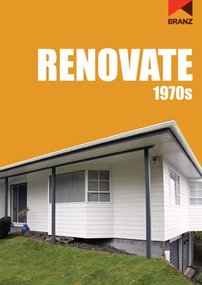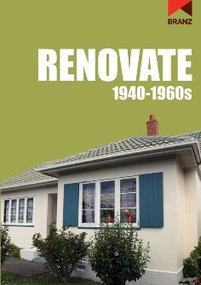Renovate: 1970s
Over 279,000 houses were built in New Zealand in the 1970s, a time of expanding suburban development. Architectural styles developed during the 1950s and 1960s influenced mass housing, and a wide range of new materials was used. Split-level homes became common on sloping sites, and many houses included garaging for two cars, with internal access. Architect-designed houses introduced different window styles and rooflines as well as new linings and claddings.
Many houses from this era are little changed since construction. Typical renovation work includes updating kitchens and bathrooms and making improvements to energy efficiency through retrofitting thermal insulation and installing modern space heating systems.
This technical resource covers:
- exactly what defines 1970s style
- how these houses were constructed and with what materials
- modifications they may have had in the decades since they were built
- typical problems and suggested remedies.
This book also takes you through the issue of getting a consent for renovation work, looking at compliance paths and Alternative Solutions.
Renovate: 1940-1960s
Through the 1940s, around 28% of new domestic building work was government-funded state housing. This figure fell to below 10% during the 1960s. This book covers both state and private housing in an era of considerable growth - 262,000 houses were built in the 1960s.
Early state houses may be plain, but they are regarded today as solidly constructed homes that are ideal for renovation. Architect-designed homes of the period introduced many lifestyle features still popular today, such as larger areas of glazing, good indoor/outdoor flow and open-plan layouts.
This technical resource covers:
- exactly what defines 1940-1960s style
- how these houses were constructed and with what materials
- typical modifications they have had in the decades since they were built
- typical problems and suggested remedies.
This book also works through the issue of getting a consent for renovation work, looking at compliance paths and Alternative Solutions. Very brief examples show compliance paths that could be used for renovations such as adding a first floor addition, adding a double-glazed window where there is currently no window and adding an extension to a stucco house.

